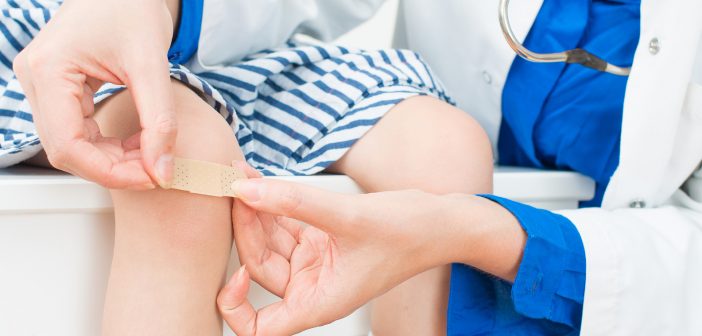As a School Mum, chances are you’ve come across Impetigo (otherwise known as School Sores). They are known as School Sores because it commonly affects school-aged children.
So, lets find out a bit more about it.
What Are School Sores?
Impetigo (school sores) is a highly contagious type of skin infection caused by the Staphylococcus or Streptococcus bacteria. The infection is characterised by inflamed blisters that pop, weep and form crusts.
Staphylococcus or Streptococcus bacteria can live harmlessly on and inside various areas of the body, such as the skin surface and nose. However, cuts and abrasions or eczema may allow the bacteria to cause infection to deeper skin tissues. Healthy, intact skin can sometimes develop impetigo too.
Where Do They Commonly Appear?
Impetigo is found generally on the face, especially around the nose and mouth, but can develop around broken skin anywhere on the body.
What Do They Look Like?
School Sores look unsightly, but aren’t dangerous and don’t cause lasting damage to the skin. They appear as red, inflamed blisters. Below is an example.

Common Symptoms Of Schools Sores include:
- The skin itches and reddens;
- A collection of blisters form;
- The blisters pop and weep a yellow, sticky fluid;
- The area develops a raised and wet-looking crust;
- The scab dries and falls off; and
- The skin completely heals after a few days.
In the case of a severe infection, symptoms may also include:
- Fever;
- Swollen lymph glands; and
- General feeling of unwellness.
Are School Sores Contagious?
School Sores are highly contagious. The School Sores are passed on when the blister pops and the fluid is highly contagious. The incubation period is the time between being exposed to the bacteria and the development of signs & symptoms. The incubation period is usually 1-3 days for Streptococcal and 4-10 days for Staphylococcal infections.
School Sores are particularly prevalent during the warmer months as they can be passed on through pools, sharing towels etc.
Impetigo blisters and crusts are filled with bacteria. This makes the condition highly contagious, particularly when the site is weeping. The skin is usually itchy, so the child scratches and spreads the infection from under their fingernails to other areas of the body or to another person. Infection can also be spread by handling contaminated clothing or articles.
How Do You Treat School Sores?
It is best to visit your GP when you first notice something unusual on the skin. A doctor will either diagnose it on its appearance or they may take a swab of the blister to check for bacteria.
School Sores can be treated topically with a prescription antibiotic ointment or antibiotic tablets may also be prescribed. It is important to finish any course of antibiotics prescribed.
A child with impetigo should be kept home from school or day care until appropriate treatment has begun and the sores on exposed areas are covered with a waterproof dressing and where necessary a crepe bandage.
If left untreated, impetigo can lead to skin abscesses.
Impetigo is very infectious and can spread easily. The sores should be washed and dressed in the following way to lessen the chance of spreading the infection.
- Wash your hands well with soap and water.
- Dry your hands thoroughly, preferably with a disposable kitchen wipe.
- Wash the sore with warm water and soap, or the lotion suggested by your doctor, aiming to gently bathe away the crusts.
- Wash your hands again using the method described above.
- Apply the antibiotic ointment (if prescribed) using a cottonwool swab.
- Cover the sores with a watertight dressing during the daytime.
- Throw old dressings into a plastic bag and seal it before discarding.
- Wash your hands again.
How to stop impetigo spreading to the rest of the family
Impetigo is very contagious. Impetigo can be transferred to another person by touching things the person with impetigo has had contact with.
The infected child should not share the bath, use the same towels, linen or flannels as the rest of the family. Do not share grooming items such as tweezers, nail clippers or toothbrushes until the sores have healed.
Everyone in the family must be careful about hand washing. Try to stop your child (or anyone else in the family) from touching the sores, and cut your child’s fingernails short to prevent scratching.
- Encourage everyone to wash their hands with soap frequently, and dry completely.
- A child with impetigo should be kept home from school or day care until appropriate treatment has begun and the sores on exposed areas are covered with a waterproof occlusive dressing.
- Cut your child’s fingernails short and encourage them not to scratch scabs or pick their nose.
- Avoid scratching or touching the sores to prevent spread to other areas of the body. Use a crepe bandage if necessary.
- Keep affected areas of skin clean and covered to minimise the chance of spreading the infection.
- Always wash your hands with soap before and after touching sores or scabs.
- Encourage children to use their own towel and face cloth. No sharing.
- Wash the child’s linen, towels and clothes in hot water. Wash all household linen in hot water while the infection is present.
- Dispose of used dressings promptly and thoroughly. Wash and dry hands after the dressings have been disposed of into a plastic bag and place bag into household waste.
Can You Prevent Getting School Sores?
Measures to prevent impetigo centre around good hygiene, including regular hand washing and bathing, and keeping your skin clean and any injuries or insect bites covered and clean.


